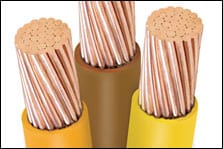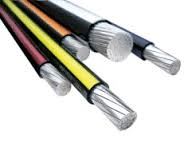Copper vs. aluminum wire. Which to use? The wire and cable industry uses a variety of metal conductors, but the two most common are copper and aluminum. Because each metal type has unique properties, they are best suited for different applications or purposes. Let’s dive into copper vs aluminum wire so you can make a more informed choice for your next project.
Copper Wire

Copper has many features and benefits: in addition to its common acceptance in most applications, it has high tensile strength and higher current carrying capacity by volume, which means the conductors are typically smaller.
Smaller conductors can be of benefit when working in tight spaces and a primary reason copper is the preferred material when wiring branch applications like to a switch or receptacle.
Most metals corrode which can be detrimental to the efficacy of an electrical system. While steps should be taken to prevent oxidation of conductors, it should be noted that copper oxidation is semi-conductive.
Copper costs significantly more than aluminum, so when moving large amounts of power is necessary, copper may be cost prohibitive. Copper is also stiffer and heavier than equivalent ampacity aluminum conductors making it difficult to work with in larger runs.
Aluminum Wire

Aluminum is a good conductor; however, there are things that must be considered before applying this 21st century metal.
A larger volume of aluminum is necessary to conduct the same electricity as copper, so typically you must upsize your conductor two sizes to accommodate the same circuit ampacity, e.g., substitute a 750 MCM aluminum for a 500 MCM copper.
Download Southwire’s Voltage Drop Calculator from their calculators page to help with proper sizing.
Aluminum is very light. Even though the conductors are bigger they will likely weigh less than the equivalent ampacity copper conductor.
Additionally, the aluminum conductors will have a larger outer diameter due to the increase in size although this is mediated using compact stranding which reduces the air gap in between the strands.
Still, the larger conductors may create the need to upsize conduit. Aluminum Wire is also “annealed” making it much more flexible than standard copper conductors and much harder to break due to mechanical wear.
Aluminum expands and contracts at a different rate than copper – each metal has a different coefficient of expansion. Steps must be taken to prevent issues of creep (the movement of metal at connection points in the system while under electrical/thermal cycling) from occurring.
In today’s electrical world, this is commonly achieved by using dual rated lugs provided by the manufacturer of the gear you purchase.
Earlier in this article, we noted that copper oxide is semi-conductive, but aluminum oxide is an insulator. It is standard practice to use an oxide inhibiting grease when making a connection at any point in your electrical system when there is the presence of an oxide accelerant (moisture or other element).
Return on investment (ROI) is very important to companies today. Thus, the most obvious advantage in selecting aluminum wire is the its lower material price.
Aluminum is used in everything today, from packaging to airplane bodies and is the most plentiful ore found on the planet and as such the supply is high and the cost associated with it is low and very stable. When employed to distribute power it is a very cost effective alternative.
Summary – Copper vs. Aluminum Wire
In the end, both copper and aluminum are popular wire materials for commercial, industrial and residential projects. The appropriate wire solution will depend on the project, situation, location, budget, code compliance and safety requirements.
If you have a question please reach out to the professionals here at Agilix Solutions. Coupled with our partner in both aluminum and copper wire, Southwire, we can help you with an answer.
Southwire is one of North America’s largest wire and cable producers and the company behind some of the greatest innovations in wire and cable installation in the past 20 years. They are committed to inspiring the lives they touch by developing innovative systems and solutions, exercising environmental stewardship, and enhancing the well-being of the communities they serve.
Agilix Solutions stocks a wide range of copper and aluminum wire sizes and colors in 500, 1,000 or 2,500 foot rolls or cut to length. Pulling heads are also available for most wire sizes.
In addition to wire, Agilix Solutions offers a variety of wire management solutions from transport to payout to save you time, money and materials. To learn more, give your Agilix Solutions account manager a call today or reach out to your nearest branch location!

